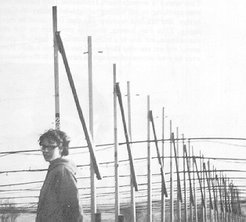Beacons in space
Pulsars are fascinating celestial bodies with an interesting history
Text Helmut Hornung

Cambridge, England, end of September 1967. The 24-year-old astronomy student Jocelyn Bell is hard at work on her doctoral thesis. She is evaluating data from a new radio telescope – long strips of paper, dozens of metres long with bumpy curves. After 30 metres of paper, the student’s trained eye detects an irregularity. A few weeks later Jocelyn Bell investigates this perturbation in more detail. She discovers that they are pulses which are repeated at intervals of precisely 1.33730109 seconds.
What does it mean? They cannot be produced by humans, because the signals always return when the mysterious transmitter – caused by the apparent daily rotation of the sky – moves past the stationary telescope. There are two possible options: either the pulses originate from an astronomical object – but from which one? - or from an alien civilisation that is trying to communicate with Earth! And in fact Bell and her doctoral supervisor Anthony Hewish call the mysterious signal Little Green Man.
Shortly before Christmas, Jocelyn Bell examines the recordings from a different region in the sky - and promptly finds a further transmitter. This time with a period of 1.2 seconds. Is there really a second alien people broadcasting on a different frequency? This seems extremely unlikely. Therefore, the only explanation is an astronomical one. But what lies behind the ticking of these cosmic quartz clocks? The answer is astonishing: objects whose existence scientists had theoretically predicted back in 1934. Their work, however, went unnoticed for 33 years before being confirmed by Jocelyn Bell.
The young researcher had discovered neutron stars which reveal their identity as pulsars. Incidentally, somebody else had listened to the signals from space in summer 1967: Charles Schisler, a young soldier in a radar station in Alaska. However, for reasons of military nondisclosure, Schisler kept the secret to himself for 40 years, only breaking his silence in the summer of 2007.
